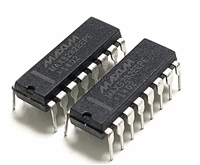www.fairchildsemi.com
AN-6005
Synchronous buck MOSFET loss calculations
with Excel model
Jon Klein Power Management Applications
Abstract
The synchronous buck circuit is in widespread use to
provide “point of use” high current, low voltage
power for CPU’s, chipsets, peripherals etc.
High-Side Losses:
The power loss in any MOSFET is the combination
of the switching losses and the MOSFET’s
conduction losses.
Typically used to convert from a 12V or 5V “bulk”
supply, they provide outputs as low as 0.7V for low
voltage CPUs made in sub-micron technologies.
P
= P
+ P
COND
(1)
MOSFET
SW
Q1 (Figure 1) bears the brunt of the switching losses,
since it swings the full input voltage with full current
through it. In low duty cycle converters (for
example: 12VIN to 1.8VOUT) switching losses tend to
dominate.
The majority of the power lost in the conversion
process is due to losses in the power MOSFET
switches. The profiles of loss for the High-Side and
Low-Side MOSFET are quite different.
These low output voltage converters have low duty
cycles, concentrating the majority of the conduction
loss in the low-side MOSFET.
High-Side Conduction Losses:
Calculating high-side conduction loss is
straightforward as the conduction losses are just the
I2R losses in the MOSFET times the MOSFET’s duty
cycle:
V IN
High-Side
Q1
V
2
OUT
P
= I
•R •
DS(ON)
(2)
COND
OUT
V
IN
L1
SW NODE
+
where RDS(ON) is @ the maximum operating
MOSFET junction temperature (TJ(MAX) ).
VOUT
–
D1
The maximum operating junction temperature is
equation can be calculated by using an iterative
technique. Since
Low-Side
Q2
RDS(ON) rises with TJ and
Figure 1. Synchronous Buck output stage
TJ rises with PD (dissipated power) and
PD is largely being determined by I2 x RDS(ON)
The spreadsheet calculator iterates the die
For the examples in the following discussion, we will
be analyzing losses for the following synchronous
buck converter:
.
temperature and accounts for the MOSFET's positive
RDS(ON) temperature coefficient. Iteration continues
in the "DieTemp" custom function until the die
temperature has stabilized to within 0.01°C.
System Parameters
VIN
12
1.5
15
V
V
VOUT
IOUT
FSW
A
300
kHz
High-Side Switching Losses:
The switching time is broken up into 5 periods (t1-t5)
as illustrated in Figure 3. The top drawing in Figure
3 shows the voltage across the MOSFET and the
current through it. The bottom timing graph
represents VGS as a function of time. The shape of
this graph is identical to the shape of the QG curve
contained in MOSFET datasheets, which assumes the
gate is being driven with a constant current. The QG
Table 1. Example Synchronous Buck
A spreadsheet to aid in the estimation of synchronous
buck losses is available on Fairchild’s web site on
(click here to download):
http://www.fairchildsemi.com/collateral/AN-
6005.zip. Operation of the spreadsheet is described
in the Appendix at the end of this document.
1.0.1 01/04/2006






 深入解析AD7606高性能多通道模数转换器:资料手册参数分析
深入解析AD7606高性能多通道模数转换器:资料手册参数分析

 74HC573三态非易失锁存器(Latch)资料手册参数分析
74HC573三态非易失锁存器(Latch)资料手册参数分析

 MAX3232 RS-232电平转换器资料手册参数分析
MAX3232 RS-232电平转换器资料手册参数分析

 MAX485 RS-485/RS-422收发器资料手册参数分析
MAX485 RS-485/RS-422收发器资料手册参数分析
